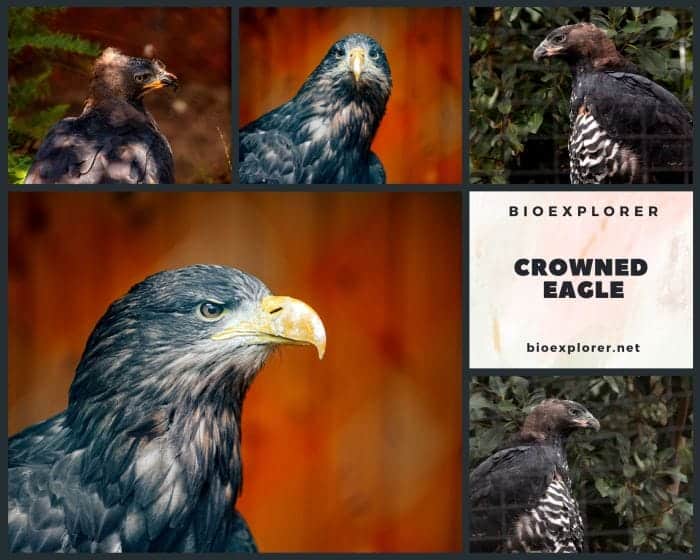
| Animalia | Accipitriformes | Accipitridae | Stephanoaetus | Stephanoaetus coronatus |
The Crowned Eagle (Stephanoaetus coronatus) is one of Africa’s most impressive birds of prey. With its distinctive furry crown and intense gaze, this powerful eagle dominates the skies and forests of sub-Saharan Africa.
Soaring on broad wings spanning up to 6 feet across and weighing over 9 pounds, the aptly named monarch of the air lives up to its regal billing. From its tremendous hunting skills to its role as a keystone species indicating ecosystem health, the crowned eagle commands attention.
This African apex predator has a diverse diet ranging from hyraxes to monkeys, with a preference for primates unique among eagles. It displays fascinating breeding behaviors, from intricate courtship rituals to extended periods of nurturing eaglets.
However, habitat destruction poses serious threats. As forests are cleared, the eagle loses nesting sites and a food supply to support its impressive bulk. It serves as a symbol of wildlife conservation efforts across Africa.
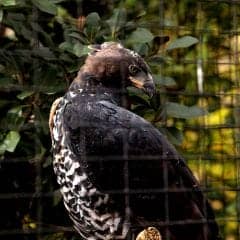

- Common Name(s): Crowned Eagle, African Crowned Eagle, Crowned Hawk-Eagle
- Family: Accipitridae
- Body Dimensions: 90 cm body length, 180 cm wingspan
- Male Plumage Color(s): Dark Brown and Black With White Markings
- Female Plumage Color(s): Dark Brown and Black With White Markings
- Habitat: Forests, Woodlands
- Diet: Mammals, Birds, Reptiles
- Native Countries: Sub-Saharan Africa
- Continent(s): Africa
- Taxonomy Classification Year: 1766
- Taxonomist(s): Carl Linnaeus
Crowned Eagle Physical Traits
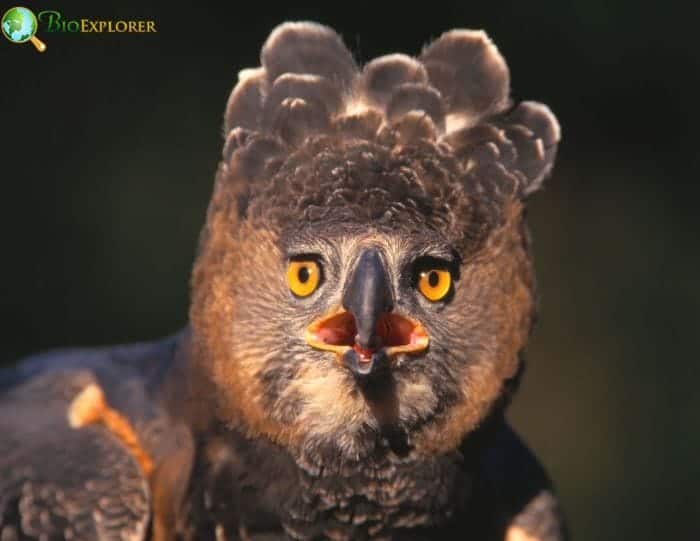
The crowned eagle is a seriously imposing raptor, considered Africa’s most powerful eagle pound for pound.
- With a total body length of around 3 feet (90 cm), it outweighs even the North American bald eagle. Males tip the scales at up to 4.1 kg (9 lbs), while females average 3.7 kg (8.4 lbs).
- One key feature is the eagle’s wingspan, which can rival the height of an NBA player. Stretching 5 to 6 feet across (152-183 cm), the broad wings provide enough lift to carry substantial prey items back to the nest tree.
- Crowned eagles also have tails proportionally longer than other eagles, spanning over 12 inches (30 cm). This improves aerial agility and maneuverability when navigating dense forest habitats.
- The eagle’s namesake physical feature is the thick, fur-like crest of dark feathers fanning out along the head and upper neck. Their other distinctive marker is intense, piercing yellow eyes beneath a prominent bony brow ridge.
- Plumage differs between ages and sexes. Adults sport dark brown upper-parts with black barring and wing edges lined in white. The head and crest feathers are a solid chocolate hue. Depending on regional variations, the undersides and legs range from creamy white to rich, reddish brown.
- Juveniles exhibit almost white undersides and shoulders, with variable brown mottling on the chest and back. Their irises are also much paler than mature birds’ bright yellow-eyed stare.
![]()
Crowned Eagle Habitats

Crowned eagles occupy a wide swath of the African continent. Their range stretches from Senegal and Ethiopia to South Africa’s Cape Province.
These apex predators primarily inhabit dense forests and woodlands, including:
- Lowland rainforests
- Riverine forests along waterways.
- Afromontane forests in elevated highlands.
- Wooded savannas interspersed with grassland.
The eagles avoid more open habitats like true arid deserts or grasslands without sufficient tree cover.
Crowned eagles frequently climbed taller emergent trees within forested areas for nesting purposes and to scan the canopy for prey from their high vantage points.
Their historic range was even more extensive before the onslaught of deforestation disrupted much of the habitat. Estimates suggest the global crowned eagle population has declined by almost 50% over the past few decades due to habitat loss.
However, robust populations still inhabit protected forest reserves across countries like:
- Uganda: Kibale National Park.
- Tanzania: Mahale Mountains National Park.
- Ivory Coast: Taï National Park.
- Angola, Malawi: scattered woodland preserves.
Smaller relictWhat is relict?A surviving species of an otherwise extinct group of organisms. populations also cling to existence in heavily cultivated zones of West Africa.
Conservation-minded raptor researchers track and study crowned eagles across remaining wilderness areas. These field studies provide valuable data to inform protective policies governing this threatened bird of prey.
![]()
Crowned Eagles’ Hunting Skills and Diverse Diet

The crowned eagle rightfully claims the title of Africa’s most powerful raptor based on its formidable hunting prowess and strength.
This apex avian predator displays a diverse diet ranging from small antelope to hyraxes, monkeys, large birds, and more. Their preferences vary based on habitat and local prey availability.
In equatorial rainforest habitats, estimates suggest 25-90% of the crowned eagle’s diet may consist of monkey species such as:
This extreme degree of primate predation is unique among eagles globally. Crowned eagles are the only raptors worldwide to preferentially hunt arboreal monkeys.
They also opportunistically hunt forest antelope like duikers and blue duikers. Outside of deep rainforests, they take a large proportion of rock hyraxes, mongooses, monitor lizards, snakes, and sizable birds like hornbills or helmeted guinea fowl.
The eagle’s prey spectrum expands when primary monkey populations decline due to habitat loss. Their flexible diet allows them to thrive across diverse wooded habitats.
Crowned Eagle Hunting Techniques
Crowned eagles employ several hunting techniques to ambush prey in the dense woods:
- Still-hunting: Patiently scanning the canopy for prey rustling in foliage from a high perch.
- Sonic-tracking: Listening for monkey troop calls, then stealthily approaching.
- Pounce attacks: Dropping or stooping onto prey from above to surprise.
Once committed to attack, the raptors rely on short bursts of speed and their stealth approach for the advantage. Their outsized gripping talons and powerful legs deliver deadly blows, easily capable of cracking primate skulls or mammal spines. At nearly the same size, a bald eagle relies more on its crushing grip to subdue prey.
![]()
Crowned Hawk Eagle Unique Breeding Behaviors
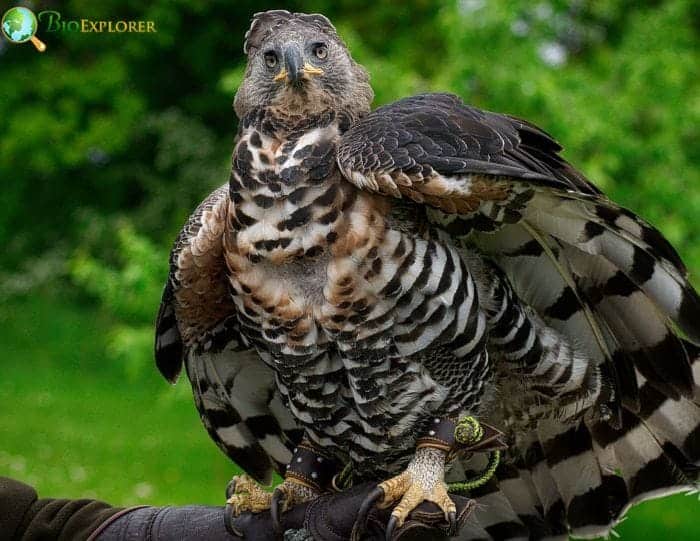
The crowned eagle displays unusually long and complex breeding habits compared to most raptors.
Courtship
Resident mated pairs engage in elaborate aerial displays to reinforce social bonds. These synchronized swooping courtship flights help attract potential mates as juveniles finally mature around their fifth year.
Males frequently present females with prey items to demonstrate hunting prowess and nourish their energy needs during breeding. Copulation may occur up to a year before egg fertilization to strengthen the pair bond.
Nest Building
Once paired, the eagles construct an enormous nest structure, typically measuring 5 feet (150 cm) across and 3 feet (90 cm) deep. Sturdily built to support the brooding eagles and large prey items, pairs often maintain and reuse nests for over a decade if undisturbed.
Nest platforms tend to be located very high in the crown of emergent trees, from around 65 to 150 feet (20-45 m) above ground. This helps shelter the eggs and chicks from potential predators.
Egg Laying and Incubation
Egg laying may only occur once every two years in the wild due to the extended period dedicated to successfully raising the young. The female typically lays one or sometimes two eggs.
Both sexes participate in incubating the eggs over an approximately 50-day period. However, the female takes the majority of daytime incubation shifts.
Hatching and Fledging
The single chick (rarely two) emerges covered in fluffy white after hatching. Already almost the size of a human toddler, despite the huge size disparity between adults and hatchlings, they grow rapidly.
After around 16 weeks, the eaglet flees from the lofty nest, yet it cannot hunt proficiently. Fledging means it can fly enough to leave the nest, not signal independence.
Post-Fledging Parental Care
The juvenile eagles then rely on their parents to provide all their food for up to another year after leaving the nest. This extraordinarily prolonged period of post-fledging parental care may last over twice as long as similar large eagles.
However, the payoff is a significantly higher chance of survival to sexual maturity and breeding age. After five to six long years of honing their skills with parental support, the juvenile finally transitions to full independence.
![]()
Crowned Eagle Interactions with Other Wildlife
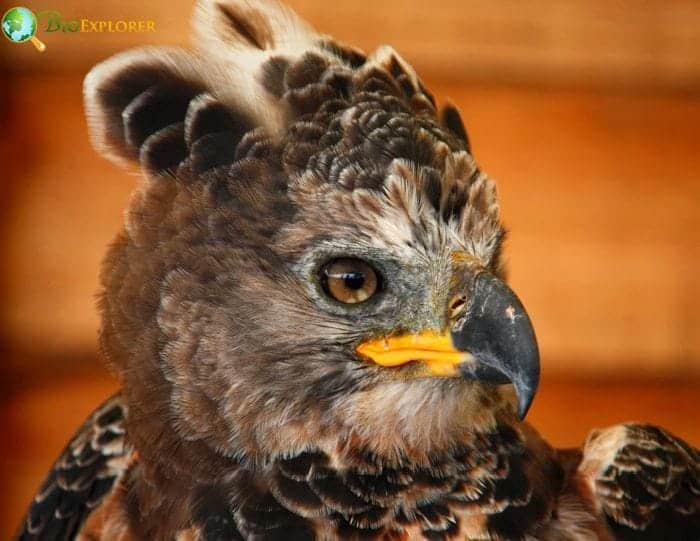
As an apex avian predator, crowned eagles interact with diverse species across the food chain.
Competition for Prey
They compete directly for similar prey items with other major predators like:
- Leopards
- Chimpanzees
- African Golden Cats
- Pythons
- Crocodiles
- Baboons
All these mammals are heavier than crowned eagles and will readily steal uncovered kills. Leopards, in particular, take more of the same monkey prey on average.
Threats to Eggs and Juveniles
Though adult eagles are impervious to most species, eggs, and juveniles face threats from:
- Honey badgers
- Gray mongooses
- Other large mongoose
These aggressive mammalian carnivores readily raid unattended nests in treetops to consume eggs.
Even formidable primates, such as adult male mangabeys, will jointly mob aerial crowned eagles to drive them away from monkey troops. Baboons have also reportedly managed to kill a subadult eagle.
Mobbing by Smaller Birds
Adult crowned eagles showing agitation near nests or attacking groups get harshly mobbed by smaller birds like:
- Hornbills
- Drongos
- Starlings
While annoying, persistent mobbing likely helps the smaller species by signaling imminent danger to take cover.
![]()
Conservation Status and Threats from Humans
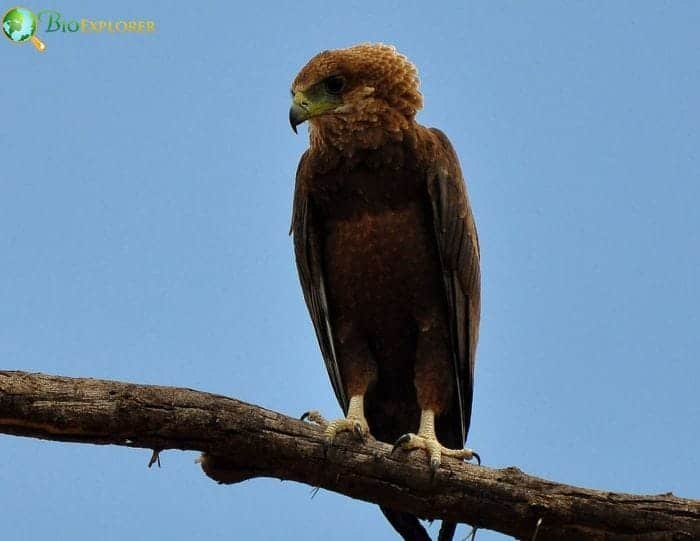
While a resilient species compared to some raptors, the crowned eagle faces several severe threats from expanding human activity, leading to a troubling population decline.
The International Union for Conservation of Nature (IUCN) officially lists the crowned eagle as Near Threatened on the global Red List of endangered species.
However, models suggest their population numbers have decreased by up to 50% over the past few decades as threats intensify.
The primary threat is widespread deforestation across sub-Saharan Africa, which cuts into necessary nesting and hunting habitat. Expanding palm oil plantations have also driven extensive forest losses.
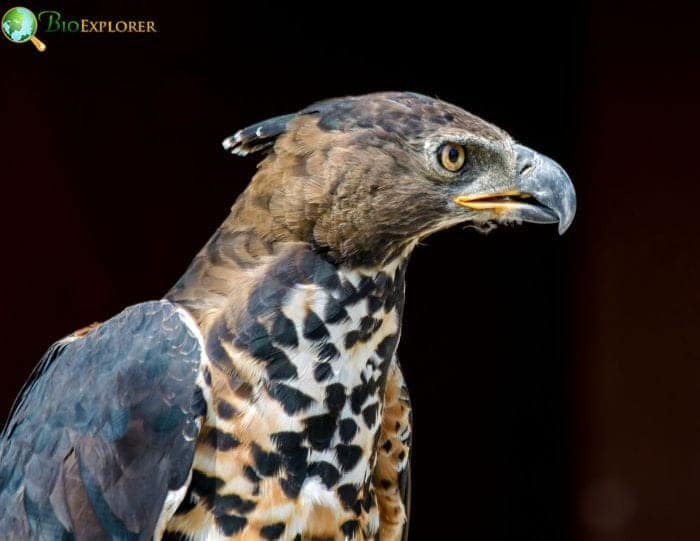
There is also direct persecution of crowned eagles out of misplaced fear for small livestock, ignorance, or economic motives. Some are hunted for meat consumption by impoverished communities.
Habitat fragmentation leaves the remaining territorial pairs more isolated and less resilient against inconsistent breeding success or other challenges. Urgent conservation action is warranted to preserve crowned eagle populations for future generations.
![]()
Importance of Conservation for Crowned Eagles
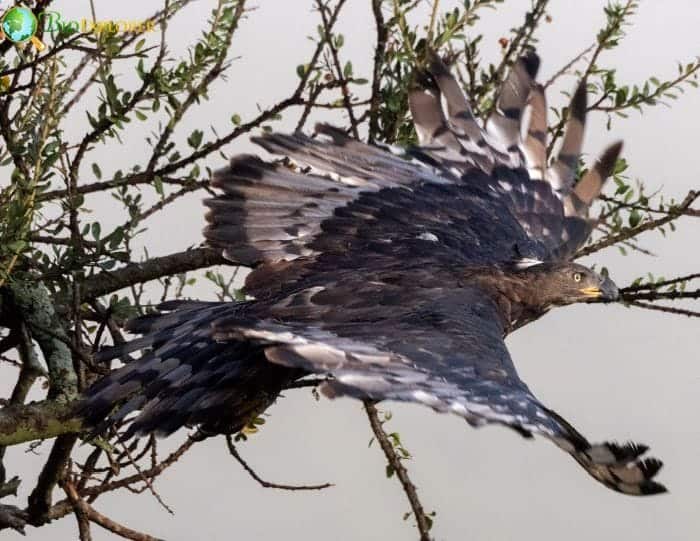
While biodiversity loss is always unfortunate, there are compelling ecological and economic reasons to prioritize conservation initiatives benefiting the crowned eagle.
Keystone Species
As apex predators regulate complex food webs, healthy crowned eagle populations support the entire ecosystem. Their decline degrades critical habitats.
Regular predation and nutrient cycling help sustain the rich biodiversity characterizing Africa’s tropical forests and wooded savannas.
Indicator Species
Scientists consider crowned eagles an “umbrella species. ” As wide-ranging predators depend on large intact habitats to thrive, their population trends signal the broader health of interlinked species and ecosystems.
Just as canaries provided warnings in coal mines, dramatic drops in breeding pairs provide early warnings of alarming forest destruction that ultimately affects human communities.
Seed Dispersal
While not a primary ecological role, crowned eagles supplement essential seed dispersal and propagation when they perch in fruit-bearing trees like figs to scan for prey.
Even the decaying carcasses of monkey prey contain seeds that get a dispersal opportunity with the body as fertilizer.
Pest Control
By significantly predating destructive rodents, insectivorous mammals, and snakes, breeding crowned eagles can benefit crop yields and reduce risks posed by crop raiders around settlement buffer zones.
Ecotourism Potential
Majestic wildlife, including rare primates, forest elephants, and crowned eagles, draw visitors willing to pay for ecotours or stays on preserves. Nesting grounds can anchor forest conservation.
Simply put, Africa’s wilderness areas cannot spare losing its monarch of the skies. From ecological services to economic incentives, the magnificent crowned eagle merits delivering vigorous protection.
![]()
Crowned Eagles Fun Facts
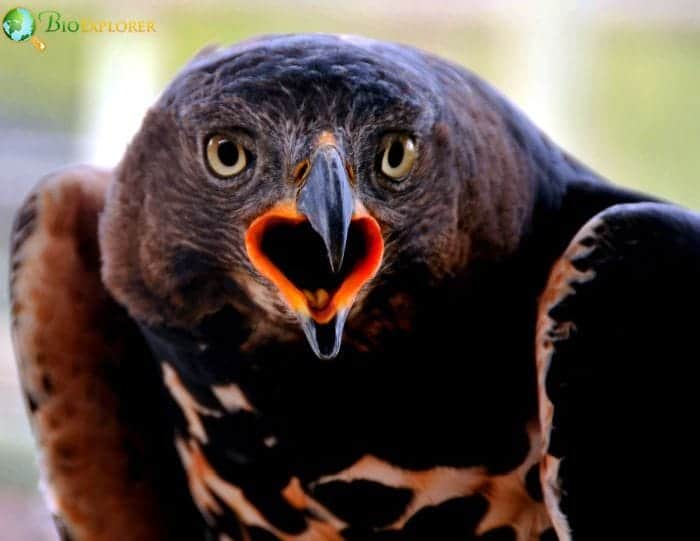
- Crowned eagles have unusually large and powerful talons for their body weight, comparable in size to much heavier golden eagles, which can weigh twice as much.
- Their full breeding cycle from initial nest building to final juvenile independence takes the longest known of possibly any raptor species at up to 3 years until the next breeding attempt.
- Unique among other eagles and globally as a raptor, an estimated 25-90% of the crowned eagle’s diet can consist of arboreal monkeys like colobus, vervets, and mangabeys, depending on the habitat.
- Once attacked by a female crowned eagle targeting their young, an aggressive mob of adult Sanje mangabey monkeys turned the tables. It killed the eagle mid-attack, showing their protective ferocity.
- The crowned eagle’s historic range was wider before extensive deforestation over decades reduced the global population by an estimated 50%, confining them to protected areas.
- Nest platforms are often constructed at a staggering 65-150 ft high upon emergent canopy trees, likely an added anti-predator adaptation to protect their eggs and chicks.
- Crowned eagle pairs may maintain ownership and reuse the same gigantic 5 ft wide, 3 ft deep nest for over a decade if the structure remains undisturbed by storms.
- The distinctive “crown” that gives the species its name consists of fur-like, thickened feathers layered over the adult’s head and upper neck.
- Rock hyraxes are a vital alternate prey species for crowned eagles across hillsides and rocky outcrops outside dense rainforest habitats.
- The extinction of the impressive Madagascar crowned eagle, an offshoot now only known from subfossils, mirrors the range loss occurring due to habitat destruction across continental Africa.
![]()
Frequently Asked Questions
What is the distribution and habitat of the crowned eagle?

The crowned eagle, also known as the African Crowned Eagle, is a large bird of prey found predominantly in southern Africa. These crowned eagles are known for their homes in dense woodlands and forests, often far from open habitats. They have also adapted well in urban and semi-urban areas, showing an extensive distribution from the Eastern Cape to Senegal.
How does a crowned eagle’s long tail impact its flight pattern?
The crowned eagle’s long tail imparts control and maneuverability in flight, especially necessary in the dense woodland habitats it calls home. Although the crowned eagle’s long, rounded wings and long tail are better suited for a fast, agile flight through trees than an open-country hunter like the martial eagle, it has an undulating display flight.
How does the African crowned eagle differ from the martial eagle?
While the crowned eagle is known as the African crowned or crowned hawk-eagle, and the martial eagle is Africa’s largest eagle, they have differences in their habitat and physical characteristics. The African crowned eagle has a long tail and large paws, lives in dense woodlands, and possesses an undulating display flight. Conversely, the martial eagle has a considerably shorter wingspan, akin to soaring and surveying open terrains.
What are the unique features of the crowned eagle’s physical characteristics?
The crowned eagle is a sizable eagle with unusually large talons and strong legs. These enhancements enable the species to tackle relatively large prey. The commander of a long tail and rounded wings, the crowned eagle is also distinguished by its double crest.
How does the young crowned eagle differ from the adult in terms of appearance?
A young crowned eagle initially carries a buff coloration on the head, neck, and underparts. The upper parts are brown-black, with a significant amount of white-tipped feathers. The crest becomes more apparent as they mature, and their plumage changes to the definitive adult configuration.
What is the primary food source of crowned eagles in their habitat?
Befitting their habitat, crowned eagles primarily prey on mammals, including the rock hyrax and small antelopes. However, given their large talons and strong legs, they can also preface on larger mammals. Shockingly, there have been instances of crowned eagles attacking human children.
What sound does the crowned eagle make?
Crowned eagles often call using a distinctive, somewhat human-like yell. These calls are used in territorial disputes and communication with their mates and young ones.
How does the crowned eagle’s undulating display flight work?
The crowned eagle’s undulating display flight comprises a series of steep climbs followed by downward glides, forming a rollercoaster-like pattern. This is often accompanied by loud calls. The flight displays are a part of both mate attraction and territory defense.
Are there subspecies of the Crowned Eagle?
Yes, one notable example is the Malagasy Crowned Eagle. However, this subspecies is extinct and disappeared after humans settled on Madagascar.
How does the crowned eagle use its large talons?
The crowned eagle’s unusually large talons and strong legs equip it to tackle relatively large prey. They often use their large talons to grip and carry their prey during flight or deliver a powerful killing blow.
![]()
The crowned eagle is one of Africa’s most potent avian apex predators.
From its impressive hunting prowess to its role as an umbrella species for conservation, this magnificent raptor demands attention and protection.
With the ability to tackle prey nearly 8 times its weight using its vice-like talons, the crowned eagle deserves its “powerful” reputation. Its unique preference for monkeys as prey provides valuable insights into primate social dynamics.
This mighty hunter also displays fascinating breeding behaviors unseen in similar eagle species. Curious, charismatic juvenile crowned eagles take years to master the complex skills, allowing their dominance of forest skies.
However, extensive habitat loss poses a severe threat. Attempts to mitigate climate impacts on human communities cannot ignore how preserving robust crowned eagle numbers preserves African ecosystems.
Their contributions cascade across interlinked food webs, from seed dispersal to pest control. Conserving adequate habitat buffers safeguards this majestic bird and all who depend on thriving biodiversity for productive sustenance and awe-inspiring beauty.
The crowned eagle merits the developing pride we’d take in ensuring our descendants gaze up at Africa’s magnificent monarch. After millennia of coexisting challenges, we cannot fail to be responsible environmental stewards now.











